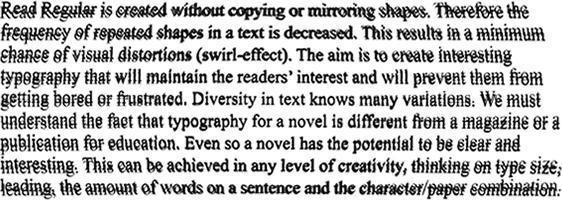After an input from one of our lecturers, Will, where he state that if we aren’t aware of the different Additional Support Needs (ASN) then we were being ignorant. Two of my friends and I have decided to look into Dyslexia, Dyspraxia and Dyscalculia. As normally if you have one of these ASN then there is a stronger chance you will have another, if not all three as these come as a family of ASN. Through this blog post I am going to briefly give some information on Dyslexia.
What is Dyslexia?
“The word ‘dyslexia’ comes from the Greek and means ‘difficulty with words’.” (British Dyslexia Associations, no date)
Dyslexia is a common addition support need – a person who has dyslexia struggles with reading, writing and spelling. It is a lifelong problem for those who have dyslexia but there is support out there for them.
1 in 10-20 people have Dyslexia – therefore in a common sized primary school class in Scotland, it is more than likely that teachers will have at least one child who struggles with dyslexia if not more.
Unlike many ASN, Dyslexia has no impact on intelligence.
Dyslexia mainly affects the person’s ability to processing and remembering information that see and hear which can impact upon the person’s learning and the acquisition of literacy skills.
The Signs of Dyslexia
The signs of dyslexia are for the majority, spotted when they are in primary school and begin to focus on reading and writing.
The NHS (no date) states that the signs of dyslexia may include:
- “read and write very slowly
- confuse the order of letters in words
- put letters the wrong way round – such as writing “b” instead of “d”
- have poor or inconsistent spelling
- understand information when told verbally, but have difficulty with information that’s written down
- find it hard to carry out a sequence of directions
- struggle with planning and organisation”.
Dyslexia and The Eyes
The reason I had chosen to look into Dyslexia is that I have a form on dyslexia called Irlen’s Syndrome (which is commonly known as visual stress) which affects how you see text which is common with people with dyslexia. Below is an example of visual stress.

People with dyslexia often cannot focus when reading standard black writing on white paper. People with dyslexia tend to prefer to have the paper a different colour – the colour of the paper depends on the person. I prefer grey paper which is very uncommon whereas yellow can be very common. There are things called overlays which are coloured plastic sheets for people who have Dyslexia or Irlen’s syndrome to place over paper to filter the paper to the colour they need. Below I have included a yellow and grey overlay but there are multiple different colours which can be seen at the Dyslexia website (ADD hyperlink). For some even the overlays are not even and they have tinted glasses to the colour they need.
Dyslexia and the eyes, Irlen’s syndrome or visual stress can cause symptoms such as the following:
- “Blurred letters or words which go out of focus.
- Letters which move or present with back to front appearance or shimmering or shaking.
- Headaches from reading.
- Words or letters which break into two and appear as double.
- Find it easier to read large, widely spaced print, than small and crowded.
- Difficulty with tracking across the page.
- Upset by glare on the page or oversensitive to bright lights.”
(British Dyslexia Association, no date).
This can affect the child’s reading ability, making reading very tiring and a chore for children who suffer from it. However, in my own experience after getting the appropriate support, through my grey overlay, I found my love of reading come back.
What can a teacher do to help?
The following advice I have taken from dyslexia.com (Hodge, 2000).
- Make sure anything that needs to go home, for example messages about when they need to take their physical education kit in, when parents even is. their homework etc, is all written down in a diary and checked before they leave, The advice also suggests getting them to have a couple of friends phone numbers at the front of the diary in case they are confused by what they are to do they can phone and check.
- Break down tasks and instructions into short chunks of information that is easy to remember.
- When they are copying from the board, try writing every line in a different colour of every second word underlined. With the technology these days, if you are using power point or interactive smart boards if you have a child who needs a yellow overlay, make the slides have a yellow background – this does not make a difference for anyone else in the classroom but makes it easier for the person who needs the overlay.
- Make sure the reading stays on the board long enough for the children to read (and if necessary copy it down) it thoroughly and not rush.
The website has lots of advice on different areas including: reading, writing, copying from the board, spelling, maths, homework among others.
More information
Irlen’s Syndrome http://www.irlen.org.uk/
Dyslexia Shop http://www.thedyslexiashop.co.uk/stationery-for-dyslexics/specialist-paper.html
Advice for in the classroom http://www.dyslexia.com/library/classroom.htm
References
British Dyslexia Association (No Date) Dyslexia and Specific Difficulties: Overview Available at: http://www.bdadyslexia.org.uk/dyslexic/dyslexia-and-specific-difficulties-overview Accessed on: 23/01/16
Hodge, P. (2000) A Dyslexia Child in the Classroom: A Guide for Teachers and Parents Available at: http://www.dyslexia.com/library/classroom.htm Accessed on: 27/01/16
National Health Service (No Date) Dyslexia Available at: http://www.nhs.uk/conditions/Dyslexia/Pages/Introduction.aspx Accessed on: 23/01/16

















